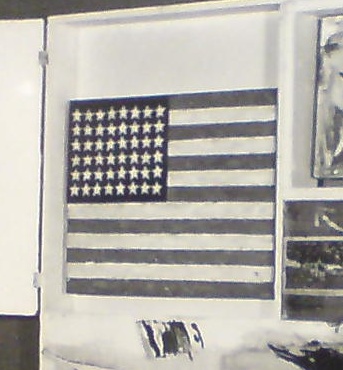
So here is where, after a few months of searching, I basically get caught up to the editors of Johns’ collected writings, who noted in 1996 that Johns’ Flag painting disappeared from Leo Castelli’s warehouse sometime “before June 8, 1965.”
After a couple of days of digging through the newly opened Castelli Gallery archives at the Archives of American Art, I found that date on the gallery’s insurance claim reporting the “Loss of Painting – American Flag by Jasper Johns valued at $5000 $12,000.” [the higher figure is written in by hand.]
The insurance company’s memo acknowledging the claim said that “Mr. Mellors is to meet with the assured on Wednesday afternoon regarding the details of the claim.”
June 8th was a Tuesday, and sure enough after his visit, Mr. Mellors had more to add. A follow-up memo is titled more clearly, “Theft of Painting – 6/6/65 – “Desk Explosion 65″ by Lichtenstein.” Mr. Mellors, it said, “…when discussing the loss on “American Flag” by Jasper Johns was informed of the above loss by Mr. Castelli.”
So what we have now is not just a “before June 8,” and a “loss” [although that is still the word used in relation to the Johns], but a date: “June 6” and a “theft.” And not just one work, but two.
The only other documentation I could find is a small note, “Call headquarters for 9th Precinct,” “Warehouses/ 75 Cliff St/ 25 First Ave” and the name [?] “Kay Kaz.”
The 9th Precinct is the East Village, which makes me think it was the First Avenue location. Kay Kaz, I have no idea, and I can’t find anything online so far. But this was not Leo’s handwriting, so I am assuming someone was taking this information down on the phone.
Frankly, I can’t tell if I’m more Law & Order: Art Victims Unit or Columbo, but this is feeling very real to me, trying to piece together what happened, where, when, and with whom, just using a few old memos.

The 6th was a Sunday, so it seems as if someone made a weekend visit to the warehouse, found the Johns missing from Short Circuit, called the police, then called the gallery to give instructions about following up with the police. And then on Tuesday, they filed a claim for the Johns, while seeing if anything else was missing. And by Wednesday, they found a Lichtenstein gone, too.
As it turns out, both works are similarly sized: small and portable. The Johns Flag is 13 1/4 x 17 1/4 inches, and Desk Explosion is 20 x 16 x 4–wait, 4-in? It’s a sculpture. An enamel-painted metal freestanding sculpture on a 4-inch deep base, made in an edition of 6:

Small….Explosion (Desk….Explosion), 1964, : image via lichtensteinfoundation.org
Either way, maybe tracking the Johns is now a matter of tracking the Lichtenstein.
So what do we know now? First, that the AAA’s Castelli Archive is awesome. I could blog those boxes out for days if the photo restrictions were a little more conducive. Instead, I find them more illustrative of the way that art historical information is still transmitted: in relatively hermetic dribs and drabs.
My previous assumption that the Johns may not have been “stolen” stolen because it was never reported as such turns out to have been wrong. Well, those reports existedtl, anyway, even if the Johns wasn’t exactly described as “stolen.” [I was also wrong about a couple of other assumptions and speculations I made in earlier posts, which I’ll get to separately and soon.] But generally, the information I’m finding does appear to have been found by at least someone, sometime, before. So I wonder what I’m doing: if all these curators and scholars have already been over this before, am I just playing art detective for my own belated educational amusement?
But questions still arise that keep me on the hook:
- Where’d those precise dimensions come from? Castelli? Rauschenberg? Johns himself? Someone had them on hand at the time the police were notified. I guess that answers the question about whether the Flag was an autonomous work?
- Why were Rauschenberg or Short Circuit not mentioned at all in the insurance claim?
- And the claim–and a half dozen 8×10 glossies of Rudy Burckhardt’s original photograph of Short Circuit was in Castelli’s Johns file, not his Rauschenberg file? [Just end it with an uptone and it becomes a question.]
- And what was Short Circuit even doing in Castelli’s warehouse? Wasn’t it in Rauschenberg’s own collection his whole life? In which case, why wasn’t he filing insurance claims on it?
- What IS up with that Lichtenstein?
- Rudy Burckhardt?
- And obviously, who is Kay Kaz, and what’s s/he doing in the middle of the memo about the polce?
